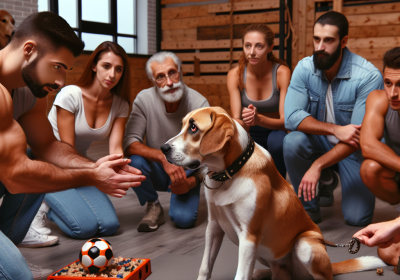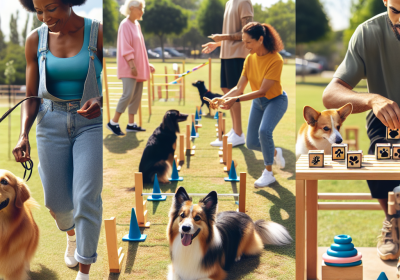Dog Agility Training for Beginners: A Fun and Rewarding Journey
As a dog lover, I’ve always been fascinated by the world of dog agility training. Not only does it provide a fantastic way to bond with our furry friends, but it also offers numerous physical and mental benefits. Today, I’m excited to share my insights into dog agility training for beginners, focusing on the joys and rewards of this delightful activity.
Introduction to Dog Agility Training
Dog agility training is a sport where dogs navigate through a series of obstacles such as jumps, tunnels, and weave poles, guided by their handler. It’s a dynamic and engaging way to challenge your dog’s physical and mental abilities while fostering a strong bond between you and your pet.
One of the great aspects of agility training is that it’s not just about competing in high-stakes events; it’s a fun and enriching activity for both dogs and their owners. Charlotte Bryan, a renowned dog trainer from Australia, beautifully sums it up: “Dog agility is a great way to build confidence and resilience in dogs and is a great way to tone up dogs and strengthen their muscles.”
Getting Started
When you’re new to dog agility training, it can be a little overwhelming to know where to begin. However, with the right approach and mindset, you can turn this into a rewarding experience for both you and your dog.
Choosing the Right Breed for Agility
While nearly any dog can enjoy agility training, certain breeds are particularly well-suited to the sport. Breeds such as Border Collies, Australian Shepherds, and Jack Russell Terriers are known for their agility and enthusiasm. However, the most important factor is your dog’s individual temperament and physical condition.
It’s essential to choose a dog who enjoys physical activity and shows an eagerness to learn. Even if your dog isn’t a typical “agility breed,” their enthusiasm and willingness to participate are what truly matter.
Understanding Your Dog’s Physical Condition and Health
Before diving into agility training, it’s crucial to ensure your dog is in good health. A visit to the vet will help you understand if your dog is physically ready for the demands of agility training. This is especially important for older dogs or those with pre-existing health conditions.
Agility training can be physically demanding, so it’s vital to start slowly and build up your dog’s endurance over time. Pay close attention to your dog’s behaviour and energy levels, and always prioritise their well-being.
Essential Equipment
When starting with dog agility training, having the right equipment is crucial. You don’t need to invest in everything at once, but having some basic pieces can make the process smoother and more enjoyable.
Basic Agility Equipment Needed
- Jump Bars: These are essential for practising various types of jumps. Adjustable jump bars are ideal as they allow you to change the height based on your dog’s ability.
- Tunnels: Tunnels are a staple in agility courses. They come in various lengths and diameters, providing a fun challenge for your dog.
- Weave Poles: These poles are set in a straight line, and your dog weaves in and out of them. Starting with a few poles and gradually increasing the number can help your dog get used to this obstacle.
- Contact Obstacles: These include the A-frame, dog walk, and teeter-totter. These obstacles require your dog to make contact with specific zones, teaching them precision and control.
Setting Up an Agility Course at Home
Creating a simple agility course in your backyard or a local park can be a great way to start. You don’t need professional-grade equipment; there are plenty of DIY options available. For example, you can use household items like broomsticks for jump bars or cardboard boxes for tunnels.
The key is to create a safe and enjoyable environment for your dog to learn. Ensure the area is free of hazards, and always supervise your dog during training sessions.
Basic Training Techniques
When it comes to training your dog for agility, patience and consistency are your best friends. Using positive reinforcement techniques can make the learning process enjoyable for both you and your dog.
Introducing Your Dog to Agility Obstacles
Start by introducing your dog to each obstacle individually. Allow them to explore the equipment at their own pace. Use treats and praise to encourage them to interact with the obstacles.
For example, guide your dog through a tunnel with a treat, letting them know that good things happen when they go through it. Gradually increase the difficulty as your dog becomes more comfortable.
Positive Reinforcement and Rewards
Positive reinforcement is a powerful tool in agility training. Rewarding your dog with treats, toys, or verbal praise when they successfully navigate an obstacle encourages them to repeat the behaviour.
It’s important to keep training sessions short and enjoyable. Dogs have a limited attention span, so frequent breaks and lots of positive reinforcement can keep them motivated.
Common Obstacles and How to Train for Them
Dog agility courses typically feature a variety of obstacles designed to test your dog’s speed, precision, and agility. Here’s a closer look at some common obstacles and tips on how to train for them.
Jumps
Jumps are a fundamental part of any agility course. They come in various forms, including bar jumps, tyre jumps, and panel jumps.
- Training Tips: Start with the bar set at a low height. Use a treat or toy to guide your dog over the jump, and reward them immediately. Gradually increase the height as your dog becomes more confident.

Tunnels
Tunnels are often a favourite among dogs due to their playful nature.
- Training Tips: Begin with a straight tunnel. Use treats or toys to entice your dog to enter and walk through. As they become more comfortable, you can introduce curved tunnels for added challenge.
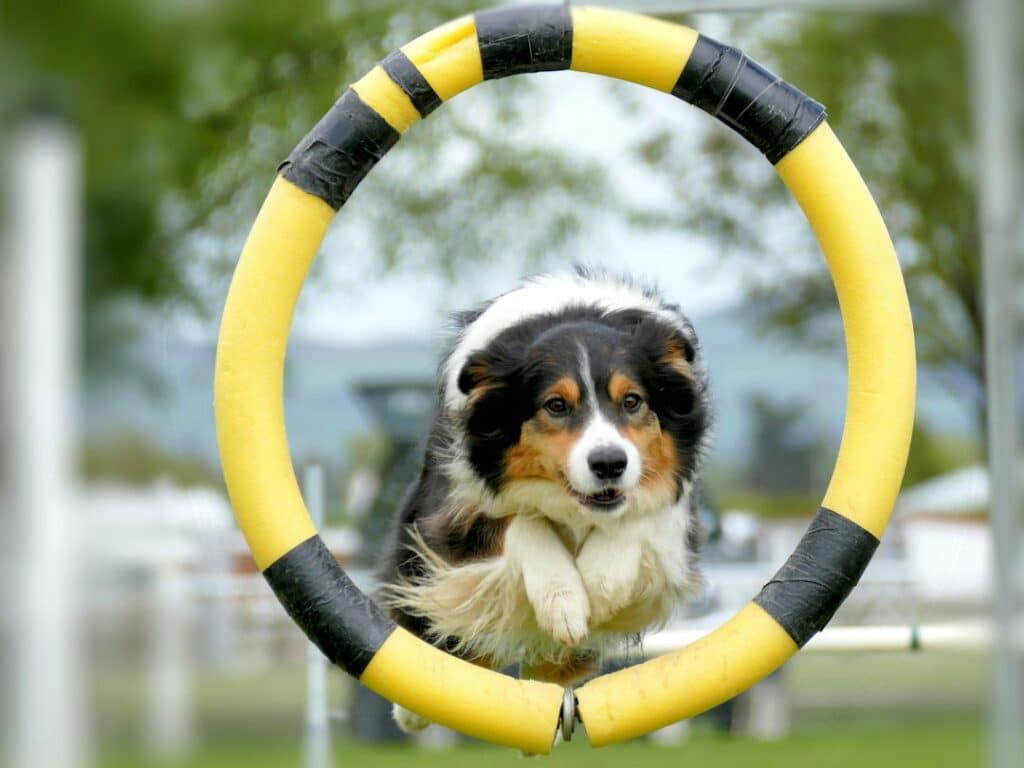
Weave Poles
Weave poles require your dog to weave in and out in a precise pattern, which can be one of the more challenging obstacles.
- Training Tips: Start with just a few poles and use treats or a target stick to guide your dog through the poles. Gradually increase the number of poles as your dog gets the hang of it. Patience and repetition are key.
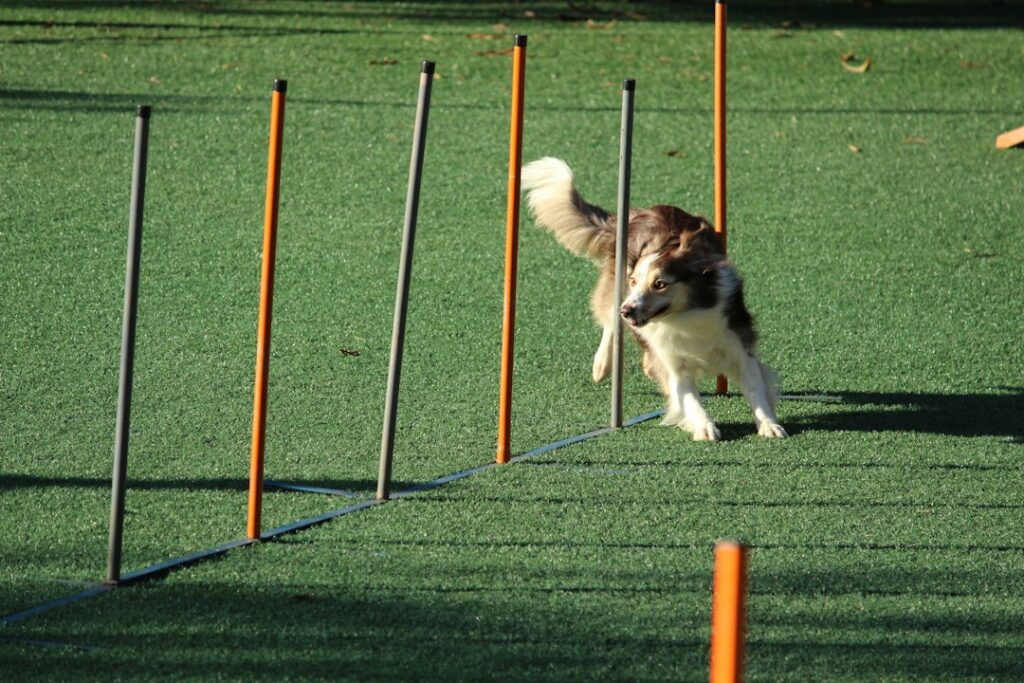
Contact Obstacles (A-frame, Dog Walk, Teeter-Totter)
These obstacles require your dog to make contact with specific zones, teaching them control and precision.
- Training Tips: Use treats and praise to encourage your dog to climb the A-frame or walk across the dog walk. For the teeter-totter, start by getting your dog used to the movement and sound. Always ensure your dog exits the obstacles safely.
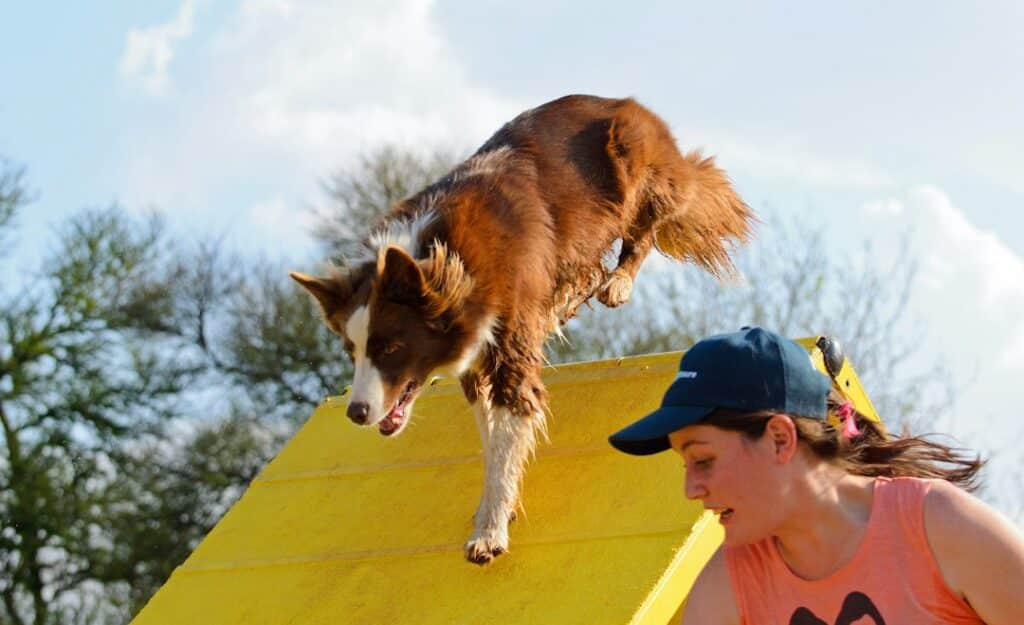
Developing a Training Routine
Consistency is crucial when it comes to dog agility training. Developing a structured training routine can help your dog progress steadily while keeping the sessions fun and engaging.
Frequency and Duration of Training Sessions
For beginners, short and frequent training sessions are most effective. Aim for 10-15 minutes per session, 2-3 times a week. This prevents your dog from becoming overwhelmed or bored.
As your dog becomes more comfortable with the obstacles, you can gradually increase the duration of the sessions. Always pay attention to your dog’s energy levels and adjust the intensity accordingly.
Progress Tracking and Setting Goals
Keeping track of your dog’s progress can be incredibly motivating. Note down their achievements and any areas that need improvement. Setting small, achievable goals can help maintain momentum and make training more rewarding.
For example, aim to have your dog successfully navigate a simple course by the end of the month. Celebrate each milestone with plenty of praise and rewards.
Joining a Dog Agility Club
While training at home can be a great start, joining a dog agility club can offer numerous additional benefits for both you and your dog.
Benefits of Joining a Club
- Expert Guidance: Clubs often have experienced trainers who can provide valuable tips and insights that you might not find on your own.
- Socialisation: Agility clubs provide an opportunity for your dog to socialise with other dogs, which can be beneficial for their behavioural development.
- Access to Equipment: Clubs typically have a wide range of professional-grade equipment that you might not have at home.
- Community Support: Being part of a community of like-minded individuals can be very motivating and provide a support system where you can share experiences and advice.
Finding a Local Club in Australia
There are many agility clubs across Australia that welcome beginners. The Australian National Kennel Council (ANKC) is a great resource to find clubs in your area. Additionally, online communities and social media groups can help you connect with local clubs and trainers.
Health and Safety Tips
The safety and well-being of your dog should always be your top priority during agility training. Here are some essential health and safety tips to keep in mind.
Preventing Injuries
- Warm-Up and Cool-Down: Just like human athletes, dogs need to warm up before strenuous activity and cool down afterwards. Gentle walks and stretches can help prevent injuries.
- Monitor Health: Regular vet check-ups are essential to ensure your dog is in good health and able to participate in agility training. Watch for signs of fatigue or discomfort during training sessions.
- Surface Matters: Train on surfaces that are safe for your dog’s joints, such as grass or specialised agility mats. Avoid hard or slippery surfaces that could lead to injuries.
Ensuring Your Dog’s Well-Being During Training
- Hydration and Nutrition: Make sure your dog stays hydrated, especially during hot weather. Provide a balanced diet to support their physical activity.
- Mental Health: Agility training should be a positive experience. Avoid pushing your dog too hard or using negative reinforcement. Always end training sessions on a positive note with plenty of praise and rewards.
- Comfort Breaks: Give your dog regular breaks during training to rest and recover. This helps prevent burnout and keeps the training enjoyable for them.
Dog agility training is a fantastic way to bond with your dog, provide them with physical and mental stimulation, and simply have fun together. As a beginner, it’s important to focus on creating positive experiences and celebrating small achievem https://pawsclawstails.com.au/sunshine-coast-dog-agility/ents. Remember, the journey is just as important as the destination.
By starting with the basics, investing in some essential equipment, and potentially joining a dog agility club, you can set the foundation for a rewarding and enjoyable activity that you and your dog will love. So why wait? Grab some treats, set up a course, and start your agility training adventure today!



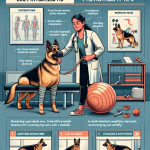
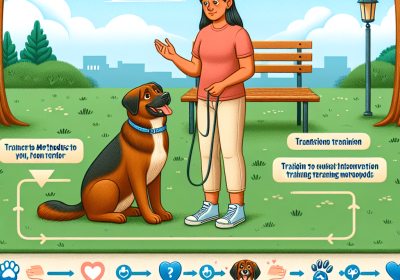
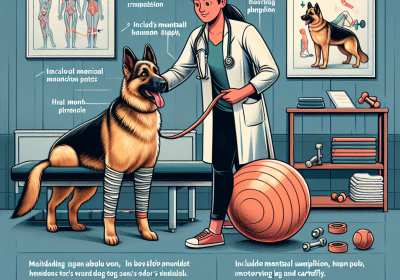
![The Dog Podcast Uncovers Startling Truths About What We Feed Our Dogs [Press Release]](https://wordcraftershub.com.au/wp-content/uploads/2024/08/dalmatian-dog-food-400x280.jpg)
